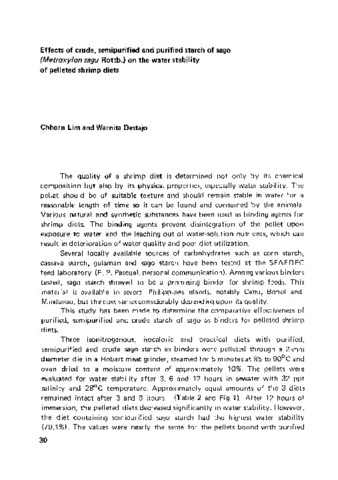Effects of crude, semipurified and purified starch of sago (Metroxylon sagu Rottb.) on the water stability of pelleted shrimp diets
- Global styles
- MLA
- Vancouver
- Elsevier - Harvard
- APA
- Help
Share
นามธรรม
A study was conducted to determine the comparative effectiveness of purified, semipurified and crude starch of sago as binders for pelleted shrimp diets. The diet containing semipurified sago starch had the highest water stability (79.1%). The values were nearly the same for the pellets bound with purified and crude sago starch. Reasons for the low binding capacity of purified and crude sago could be that the gel of purified sago is weakened due to purification, and that of the crude sago is due to the spongy material present in the product. Thus, semipurified sago starch is a better source of binder and purified crude sago. From the economic viewpoint, the cost of purified sago is prohibitive for use as binder. Both semipurified and crude sago palm starch are acceptable. Composition of shrimp diets containing various sources of sago palm starch, and binder cost and water stability of shrimp diets containing various sources of sago palm starch tested at 3, 6 and 12 hours, are tabulated.
การอ้างอิง
Lim, C., & Destajo, W. (1978). Effects of crude, semipurified and purified starch of sago (Metroxylon sagu Rottb.) on the water stability of pelleted shrimp diets. SEAFDEC Aquaculture Department Quarterly Research Report , 2(2), 30-35. http://hdl.handle.net/10862/2320
Type
Articleคอลเลกชัน



